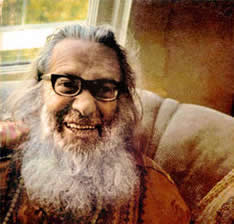
Murshid Samuel Lewis 1896-1971
“The spiritual dance has no other purpose, no other aim than to elevate humankind beyond self thought to joy, to bliss, to realization and to peace. The sincere dancer is one of the best workers for universal harmony, and so for universal peace.”
— MURSHID SAMUEL LEWIS
The originator of the Dances of Universal Peace was a spiritual renaissance man whose life and teachings were a testimony to truth, originality and embodied spirituality. Though rejected by polite society and even his own family because of his spiritual leanings, Samuel Lewis remained true to the penetrating spiritual vision of human liberation at the core of his being. His life, often difficult, bore much fruit for his students and for the world.
The Dances of Univeral Peace
The Dances of Universal Peace are a form of community prayer done by participants moving together in a circle while chanting sacred phrases gleaned from a rich diversity of religions and spiritual paths of the peoples of the world. One's own faith tradition and spiritual path is deepened and enriched by the sacred paths of others as pronunciations, chants and simple dance steps are taught for the newcomer to this form of prayer. This prayer is participatory and not a performance, therefore no audience is there to observe it.
The word, “dance” terrifies some people no matter what their age. I have at times changed it to “prayerful sacred movement” and claim our origins as Christians who live out of an incarnational (embodied) theology and spirituality. For Catholics, and for others who gather to pray, worship or come together in spiritual practice, there is no liturgy or practice without embodied sacred movement. Stand, sit, sing, reach out in greeting, use gestures, hold hands, walk in procession together, carry gifts to the altar, even prostrate on the floor at times as in ordination and religious profession of vows ceremonies. it’s all dance really. Oops, if I call it "sacred movement” does it then make the liturgy we love OK to participate in? The trouble is we don’t call it anything so the “terror” continues as we follow Jesus who had a body that moved among us, walked dusty roads to where he preached and healed people, sang and yes, surely danced as Jews have always done, and has had his life so sanitized by us so as to omit or at least not notice that his body and ours are part of the journey. So sacred are our bodies that Catholics honor them one last time with incense at our funeral liturgy, but rarely if ever say that’s what we are doing.
Over many years, I have done the Dances of Universal Peace with experienced professional liturgical dancers, children, young people, adults of different ages including people who use walkers or are in wheel chairs. What makes it work is not only my way of accommodating everyone but the trust in me given by the participants. I do not permit observers to stand back, watch, and make the courageous ones feel self-conscious.
I have noticed that ideas and concepts, those we read about or hear spoken about can change our minds, but experiences such as dance can change our hearts. One can learn about the Dances of Universal Peace by reading about them, watching a video of them being done, or hearing someone describe them. But it is only in actually experiencing them oneself that one really knows what they are and how one can feel when participating in them.
We now know that “touch deprivation” can cause death in babies. Recall the story of discovering this when infants orphaned during the Second World War began to thrive only after volunteers came daily to simply hold them while sitting in rocking chars. Holding hands within a circle of people who have not been able to gather, touch each other or even sing together for over two years during the pandemic would surely benefit from doing so again, perhaps with the plentiful use of hand sanitizer.
— Br. Joseph Kilikevice, OP, Director, Shem Center for Interfaith Spirituality
About "cultural appropriation"
The Dances of Universal Peace have been an important part of Shem Center’s work since our founding in 1993. The question of “cultural appropriation” and sensitivity to the traditions one encounters in the Dances is raised during these days of increasing awareness of this question.
My approach has always been to make every effort to be respectful, accurate and reverential in teaching and doing Dances in the traditions of others as well as my own. As the matter is discussed among dance leaders and I reflect on issues raised in this exchange, I find myself affirmed in accepting the challenge to be respectful, courageous and cautious when dance leading.
When well led, the Dances of Universal Peace can be deeply moving and powerfully transformative. One can do research and extensive reading about the world's religions and come away with a lot of information and never experience what can happen in the Dances. Samuel Lewis and Ruth St. Dennis were onto something when they passed their discovery on to their followers. I feel strongly that the religions and spiritual paths of the peoples of the world are a sacred treasury of diversity the world needs to evolve into discovering and celebrating the Creator’s love and radiance.
I often say when bringing the Dances to people that are new to them that you can think about and understand something about this sacred diversity and have what you learn remain in you from the eyebrows up. Or you can chant and dance with others and never be quite the same person you were before letting go into the Dances. The heart can be awakened and the spirit lifted by the Dances. By all means, Dance leaders are called to consult the resources that hold a deeper understanding of the context for the Dances. But one does not stop there. One leads the Dance knowing that a message is being brought into a world that considers those who are “different," as wrong!
Are the sacred traditions honored in the collection of Dances of Universal Peace ever diminished because the words, chants and dance movements used by an experienced and mentored leader may not always be done “right” or perfectly? I propose that our inadequacies do not impede the Beloved who calls us to this sacred work.
— Br. Joseph Kilikevice, OP, Director, Shem Center for Interfaith Spirituality
The Dances of Universal Peace, North America web site:
https://dancesofuniversalpeace.org
Shem Center for Interfaith Spirituality
708 North Harvey Avenue
Oak Park, IL 60302
(708) 848-1095
shemcenter1993@gmail.com
Photo Credits: Emory Mead, Stephen B. Starr, Joseph Kilikevice
The Shem Center for Interfaith Spirituality website is awarded a 2022 American Digital Design Award for excellence in design and user experience.
